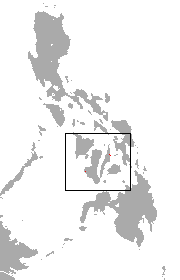Philippine naked-backed fruit bat facts for kids
Quick facts for kids Philippine bare-backed fruit bat |
|
|---|---|
| Conservation status | |
| Scientific classification | |
| Genus: |
Dobsonia
|
| Species: |
chapmani
|
 |
|
| Philippine naked-backed fruit bat range | |
The Philippine naked-backed fruit bat (Dobsonia chapmani) is a special type of large bat. It mainly lives on Negros Island in the Philippines. A few small groups were also found on Cebu Island. These bats are called "bare-backed" because their wings join together along the middle of their back. This unique feature helps them fly very well. They used to live in dark caves. There were so many of them that they left large piles of guano (bat droppings). Miners even used this guano as fertilizer.
By the mid-1980s, many forests where these bats lived were cut down. They were replaced by sugar cane farms. Because of this, the bat seemed to disappear. In 1996, experts thought the species was extinct because no one had seen it since 1964. But then, in 2000, the bat was rediscovered!
Now, only a very small number of these bats are left. They live in caves and come out at night to eat fruits from the local rainforests. When the forests were cut down for sugar farms, the bat population dropped a lot. The few bats that remain are still sometimes hunted for their meat. These bats now live in the small areas of forest that are left. If these last forests are cut down, the species will likely disappear forever. The forest where the bats live in Cebu is protected, meaning it cannot be cut down. However, there are no such protections on Negros.
Contents
What Does This Bat Look Like?
The Philippine naked-backed fruit bat (Dobsonia chapmani) is a large fruit bat. It lives in Southeast Asia, mainly in the Philippines and nearby islands. It measures about 218 to 221 millimeters (about 8.5 to 8.7 inches) from its nose to its tail. It weighs between 125 and 143 grams (about 4.4 to 5 ounces). The wings of this bat connect to the middle of its back. This makes its back look "naked" or without fur.
Where Does This Bat Live?
This bat prefers to live in limestone caves found in forests. The forest homes have natural open areas and bushy plants. Some of these plants include batino (Alstonia macrophylla), hindunganon (Macaranga species), tubug (Ficus septica), and matamban (Mallotus species). These plants grow on steep slopes. For food, the bat also uses nearby farm clearings. These areas are planted with abacá (Musa textiles), gabi (Colocasia esculenta), and coconuts (Cocos nucifera). Only about 60 hectares (about 148 acres) of forest land remain for this species. All of this land is outside the protected Central Cebu National Park.
What Does This Bat Eat?
As its name suggests, this bat eats many kinds of fruit. Because they eat fruits, they are very important for spreading seeds. They help new plants grow in different areas.
How Are We Protecting This Bat?
People once thought this bat was extinct because of three main problems. First, too many bats were hunted for their meat because they are large. Second, forests were cut down as the human population grew. Third, there was not enough protection for the bat's home, except for a few small areas in Carmen municipality.
Climate change might also affect the bat's breeding seasons. It could also harm the small areas where the bats live. The bats might also be at risk because they have low genetic diversity. This means there isn't much variety in their genes, which can make them weaker. This happens when a population becomes very small, like a population bottleneck.
In the Carmen municipality on Cebu Island, the local government has created a group. These environmental protection coordinators patrol and report problems in the bat's home. Their job is to check on cave "sanctuaries," as the government calls them. They report changes in the habitat and any bat hunting. A project to plant new trees (reforestation) is also happening. Many other towns are now following Carmen's lead to help save this bat.
There is also a law for both islands called Republic Act 9147. It is also known as the Wildlife Resources Conservation and Protection Act. This law helps to save and protect wildlife and their homes. This bat is also known as a flagship species in many areas where it lives. A flagship species is an animal that helps protect its entire ecosystem. In 2013, Bat Conservation International listed this species as one of 35 top priority species for conservation around the world.


